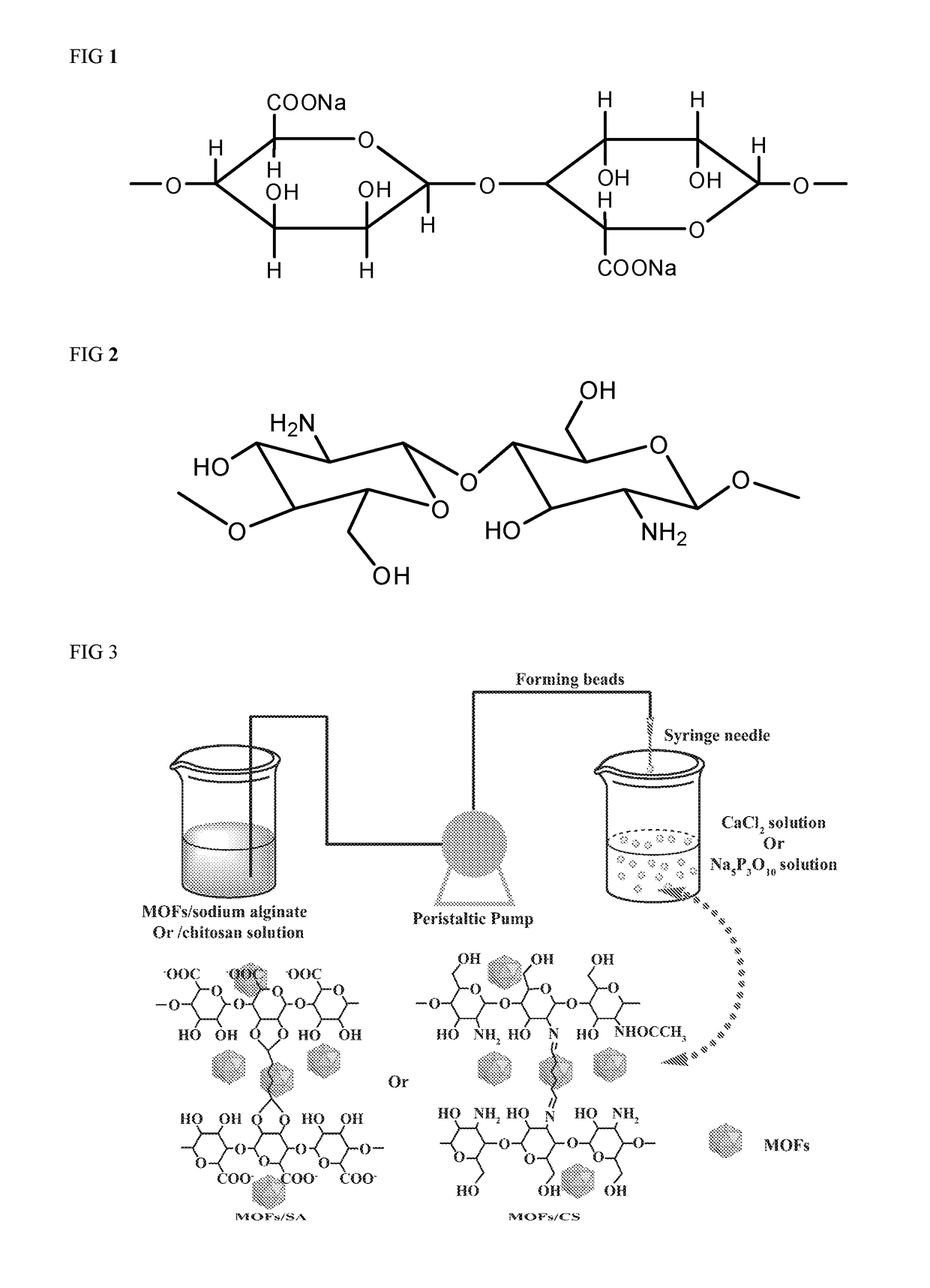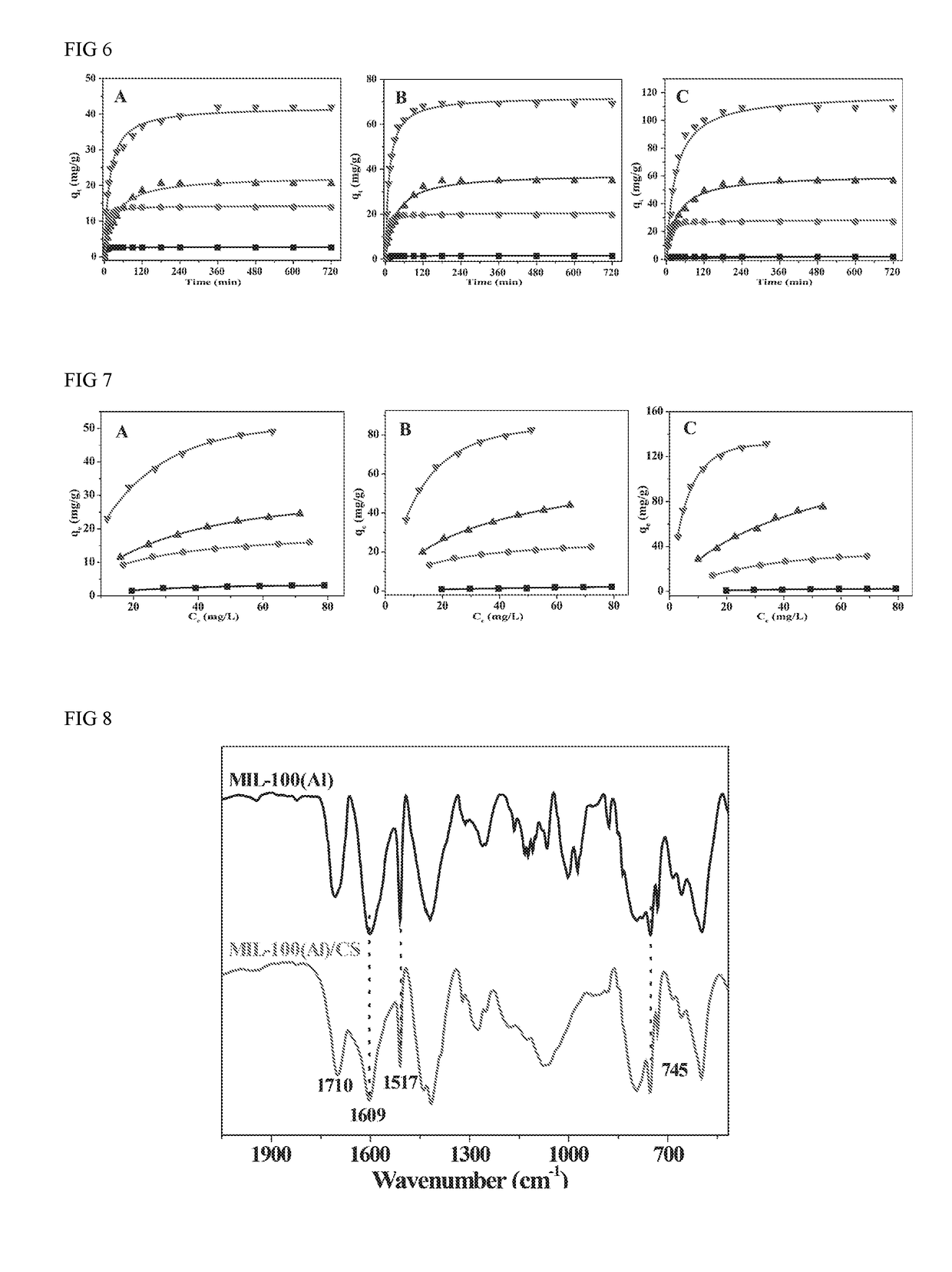Synthesis and Application of MOFs/natural Polymers Composite Beads Adsorbents
a technology of composite beads and natural polymers, applied in the field of adsorbents, can solve the problem of heavy restrictions on the use of mofs nanoparticles
- Summary
- Abstract
- Description
- Claims
- Application Information
AI Technical Summary
Benefits of technology
Problems solved by technology
Method used
Image
Examples
example 1
MIL-101(Cr) Synthesis
[0035]Particles of metal-organic framework (MOF) MIL-101(Cr) were synthesized hydrothermally. Typically, Cr(NO3)3.9H2O (2.0 g), terephthalic acid (0.83 g), HF (0.5 mL) and deionized water (35 mL) were blended and briefly sonicated resulting in a dark blue-colored suspension. The suspension was placed in a Teflon-lined autoclave bomb (50 mL) and kept in an oven at 220° C. for 8 h without stirring. After the synthesis and equilibration at room temperature, the MIL-101(Cr) solids were separated from water using a centrifuge (8000 rpm, 10 min) and washed with water and ethanol. The suspension was centrifuged and separated, the solids were placed in DMF (20 mL) and the suspension was sonicated for 10 min and then kept at 70° C. overnight. The resulting solids were separated by centrifugation, repeatedly washed with ethanol, dried under vacuum at 75° C. for 2 days. Finally, MIL-101(Cr) nanopower were stored in a vacuum desiccator in the dark prior to further use.
Synth...
example 2
MIL-100(Al) Synthesis
[0054]Particles of metal-organic framework (MOF) MIL-100(Al) were synthesized hydrothermally. Typically, Al(NO3)3.9H2O (4.2 g), trimesic acid (2.0 g) and nitric acid (62 mL, 20 wt. %) were blended and briefly sonicated resulting in a dark blue-colored suspension. The suspension was placed in a Teflon-lined autoclave bomb (100 mL) and kept in an oven at 210° C. for 3 h without stirring. After the synthesis and equilibration at room temperature, the MIL-100(Al) solids were separated from water using a centrifuge (8000 rpm, 10 min). The resulting solids were washed with DMF and separated by centrifugation, repeatedly washed with EtOH, dried under vacuum at 80° C. for 2 days. Finally, MIL-100(Al) nanopower were stored in a vacuum desiccator in the dark prior to further use.
Synthesis of MIL-100(Al) / Sodium Alginate Hybrid Beads (MIL-100(Al) / SA)
[0055]In one embodiment, 2.0 g of MIL-100(Al) nanopowder was added to 100 mL pure water stirred for 5 min and completely disso...
PUM
| Property | Measurement | Unit |
|---|---|---|
| temperature | aaaaa | aaaaa |
| wavelengths | aaaaa | aaaaa |
| wavelengths | aaaaa | aaaaa |
Abstract
Description
Claims
Application Information
 Login to View More
Login to View More - R&D
- Intellectual Property
- Life Sciences
- Materials
- Tech Scout
- Unparalleled Data Quality
- Higher Quality Content
- 60% Fewer Hallucinations
Browse by: Latest US Patents, China's latest patents, Technical Efficacy Thesaurus, Application Domain, Technology Topic, Popular Technical Reports.
© 2025 PatSnap. All rights reserved.Legal|Privacy policy|Modern Slavery Act Transparency Statement|Sitemap|About US| Contact US: help@patsnap.com



